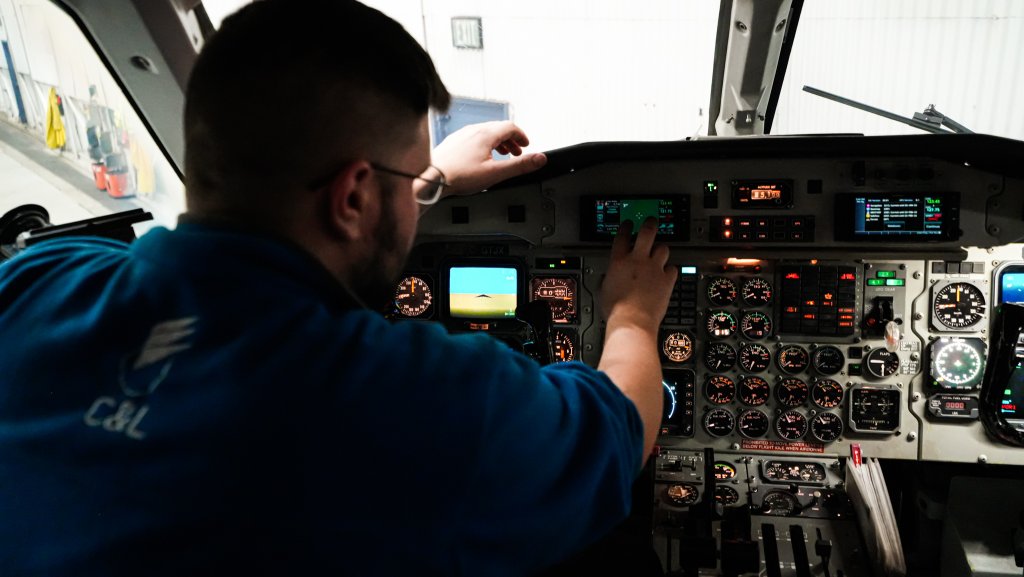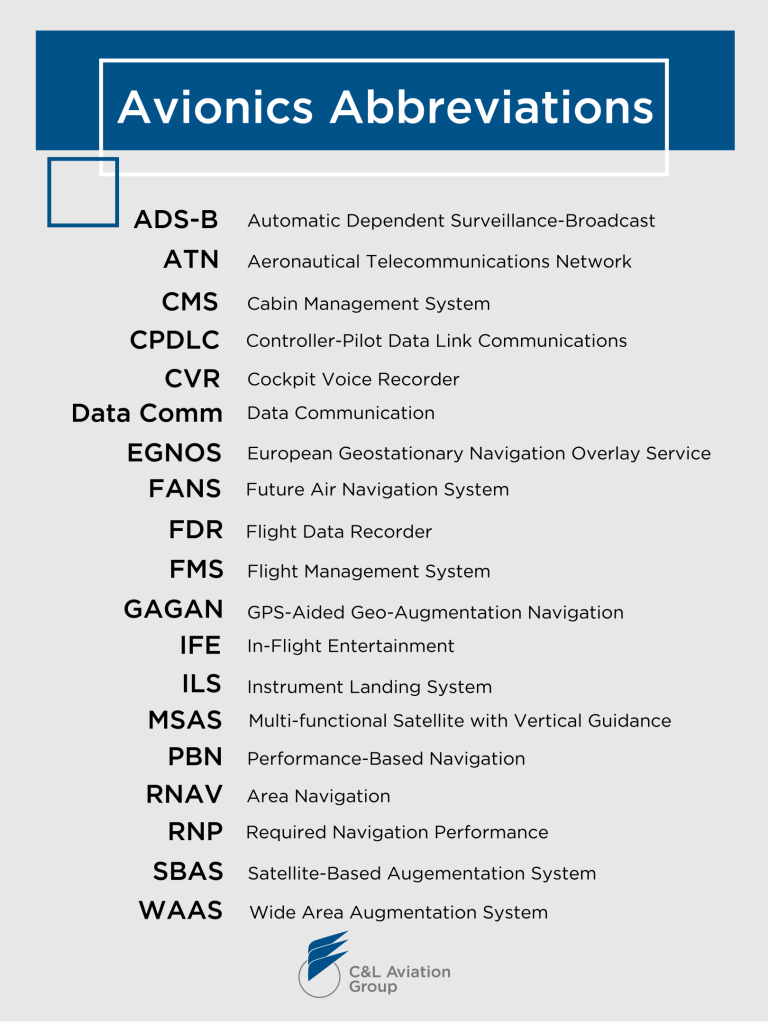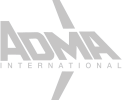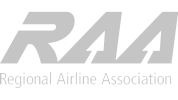
If it’s not broken, why fix it?
The truth is, like all technology, older aircraft electrical systems – known as avionics — are going to become obsolete and no longer function properly.
Avionics control a variety of electrical and technological systems in the aircraft, making them expensive to upgrade. However, trying to maintain older systems may be costly as well. This article outlines the factors to consider when deciding to upgrade your flight deck avionics.
What are Avionics Systems?
There are a variety of avionics systems in the aircraft cockpit/flight deck and cabin. The common avionics systems are listed below.
Communication Systems
These flight deck systems are for internal communication within the aircraft and external communication with other aircraft and Aeronautical Telecommunications Network (ATN) control towers.
Flight Displays
Flight displays provide data on airspeed, altitude, vertical speed, situation awareness, terrain awareness, and overall safety to the flight crew.
Navigation Systems
Navigation systems, such as Wide Area Augmentation Systems/Satellite-Based Augmentation Systems (WAAS/SBAS), determine the aircraft’s location.
Read more: Why Upgrade Your Aircraft to a WAAS/SBAS?
Fuel Systems
Fuel systems alert pilots about the aircraft’s fuel levels and accurately manage fuel usage for the intended trip.
Flight Records
Cockpit voice recorders (CVR) and flight data recorders (FDR) keep records of cockpit audio within the parameters of the avionics equipment as well as the onboard flight control operations. Different parameters may need to be recorded through the FDR, depending on where the aircraft is operating.
Cabin Connectivity
Although this article focuses on cockpit or flight deck avionics systems, we would be remiss to not mention Cabin Management Systems (CMS) and In-Flight Entertainment (IFE). These systems provide connectivity to both the cabin and cockpit.
Read more: Four Reasons to Upgrade an Aircraft Cabin Management System

Why Do Avionics Systems Need to be Updated?
Safety and Reliability
We’ve all heard “Safety First,” and that applies to aircraft avionics systems as well. Older flight deck avionics are not as accurate as new systems. New, innovative systems are safer and more reliable.
Mandates (Domestic and Foreign)
Regulations, issued by the FAA or equivalent, mandate certain installations to ensure safety and best practices. For instance, as of January 1, 2020, all aircraft flying over 18,000 feet must have Automatic Dependent Surveillance-Broadcast (ADS-B) installed.
If you are flying internationally, you should be aware of what avionics systems are mandated in other countries. For instance, in Europe (EU Airspace), Future Air Navigation Systems (FANS)-1/A+, Controller-Pilot Data Link Communications (CPDLC), and Data Comm are mandated by the EASA.
Obsolescence
Over time, avionics on an aircraft become obsolete and no longer meet the requirements of Performance-Based Navigation (PBN) or Required Navigation Performance (RNP) / Area Navigation (RNAV). (Most domestic and international airports require these systems to operate within their region.)
Also, the increasing prevalence of newer avionics systems, such as Data Communication (Data Comm) and WAAS-enabled FMS, at airports means there is less support for older systems, such as Instrument Landing Systems (ILS) – if they support older landing approaches at all.
High Costs
Obsolete avionics systems may be more costly and difficult to maintain. The components necessary for maintenance, repair, or upgrades may not be readily available.
Further, aircraft with updated avionics systems that are compatible with the airport’s systems will be prioritized. (This is often referred to as “Best Equipped, Best Served.”) Meanwhile, aircraft with older systems may find themselves in a holding pattern, waiting to land. Having older avionics may be costing operators fuel and time.
Technical Support
Technical support for older systems is decreasing. Some avionics companies, such as Universal Avionics, have discontinued support for their older systems. Further, it may be impossible to upgrade older systems to new or future standards because older systems may not be compatible with newer systems.
Resale Value
Aircraft with old or obsolete flight deck avionics will have a decreased value on the resale market. Also, older avionics systems are 300 to 500 pounds heavier than new systems. On the resale market, it may be difficult to compete against aircraft that do not require expensive upgrades or time-consuming avionics overhauls.

What Factors to Consider When Pricing Avionics Upgrades?
The amount you will pay for upgrading avionics will depend on the kind of avionics systems being installed, the type of aircraft, and the manufacturer providing the systems. When pricing avionics systems upgrades, there are some factors to consider.
1. Is other maintenance required for installation?
In addition to pricing avionics upgrades and installations, you may also want to consider any necessary maintenance, inspections, or modifications that may be required to accommodate the upgrades. You can minimize downtime by having other work done while the avionics are being upgraded.
2. Can installation and maintenance be done locally?
To minimize downtime, you might want to determine if the installation and any necessary maintenance be completed at your usual MRO or avionics shop. If not, the aircraft may have to be ferried to another location or multiple locations, which may be costly and time-consuming.
3. Is an integrated or non-integrated system best for your aircraft?
You’ll also need to determine which avionics system is the right fit for your aircraft. On the one hand, you may require a fully integrated avionics system, which would require a complete overhaul of the flight deck (this usually includes the flight management system (FMS), radios, audio systems, autopilot, cockpit displays, flight director, flight deck connectivity, etc.).
On the other hand, you might be able to have a non-integrated system installed. Non-integrated avionics systems are newer components and equipment that work with the older systems already installed. Installing non-integrated systems may be more affordable than fully integrated ones, but engineering must ensure that the newer systems are compatible with the older systems.
4. Is it worth the cost?
Once you have priced your options, you’ll want to consider the cost of the upgrade against the value of the aircraft. Sometimes, upgrading an older aircraft may cost more than the aircraft is worth. In those instances, it may be more economical to purchase a newer aircraft that already has an updated avionics system installed.
Avionics Advice
Upgrading the avionics systems in your aircraft can be a big investment, so you want to ensure that you are getting the right systems to meet your needs and any compliance regulations.
We conclude our article with three pieces of advice:
- Discuss your avionics needs with your trusted MRO or avionics shop to determine if your avionics systems are up to date and compliant with regulations. You can also talk about new avionics options and what may best fulfill your aviation needs.
- Work with a shop that is an authorized dealer of avionics systems and has experience installing these systems.
- Ask about the shop’s lead time and whether they have the necessary inventory. This helps determine how long it will take to have the systems installed.


















